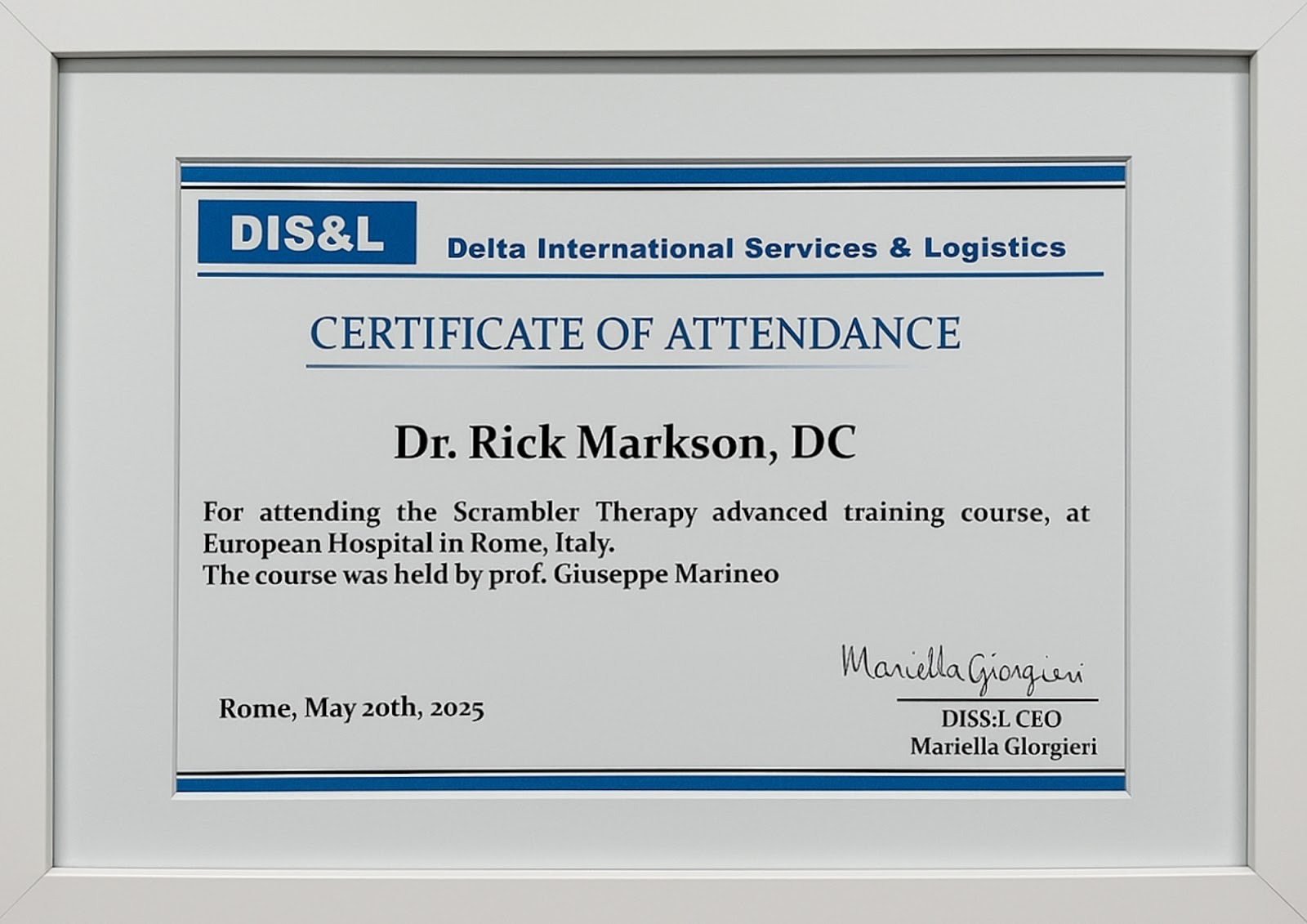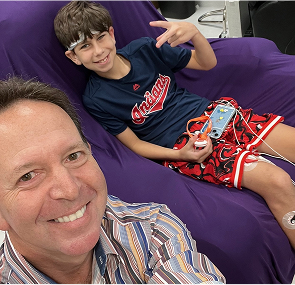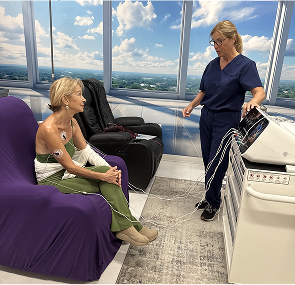Can I Continue My Current Pain Medications With Scrambler Therapy?

Yes, many patients continue their medications during Scrambler Therapy. But drug interactions, especially with opioids, may require monitoring or changes.
Patients managing chronic pain often ask whether they need to stop their current pain medications when starting Scrambler Therapy. This therapy is a non-invasive treatment designed to retrain nerve signals, offering pain relief without drugs. But the concern about treatment compatibility with ongoing medication use is valid—and deserves clear answers.
This article explains how Scrambler Therapy works, which medications may need adjustment, and how it fits into a comprehensive pain management plan.
What Is Scrambler Therapy?
Scrambler Therapy is a non-invasive electrostimulation technique used to reprogram pain signals in people with chronic nerve pain.
- It works by delivering electrical impulses through surface electrodes.
- These impulses interfere with pain messages sent to the central nervous system (CNS).
- It replaces pain signals with “non-pain” signals through the peripheral nerves.
Mechanism of Action:
Typical Candidates: Patients with neuropathy, post-surgical pain, chemotherapy-induced neuropathy, or complex regional pain syndrome (CRPS).
Session Details:
- Lasts around 30–45 minutes
- Often given over 10–12 sessions
- Painless and non-surgical
Scrambler Therapy is not a drug; it’s a neuromodulation treatment that can complement pharmacologic strategies.
Overview of Common Pain Medications Used Before Therapy
Before beginning Scrambler Therapy, patients are often on various medications that manage different types of chronic pain.
Common Classes of Pain Medications:
These medications have varied effects on nerve pathways. Their interaction with Scrambler Therapy depends on how they influence the nervous system's receptiveness to reprogramming.
Can Pain Medications Be Continued During Scrambler Therapy?
Yes, most patients can continue their current pain medications while receiving Scrambler Therapy.
However, some cases may require adjustments based on the type of drug and therapeutic goals.
Key Factors:
- Physician recommendation: Each medication should be evaluated by your pain specialist.
- Therapy overlap: Some drugs may interfere with the effectiveness of neuromodulation.
- Individual response: Tolerance, pain intensity, and clinical history vary.
Examples of Combined Use:
The safest approach involves shared decision-making between the patient and healthcare provider.
Which Medications May Interfere With Scrambler Therapy?
Some drugs can blunt the effects of Scrambler Therapy, especially those that alter CNS signal processing.
Medications That May Reduce Therapy Effectiveness:
- Opioids (e.g., fentanyl, tramadol, morphine): May saturate receptors and reduce signal receptivity
- CNS depressants (e.g., clonazepam, diazepam): Can cause sedation overlap or dampen nerve activity
- Muscle relaxers: May interfere with neural feedback loops
These medications can create receptor competition, limit signal transduction, or reduce the CNS's plasticity—all of which Scrambler Therapy relies on.
Physicians may recommend tapering these drugs to optimize the impact of the therapy.
Adjusting Medications Safely with Physician Oversight
Never adjust or stop medications on your own.
All changes during Scrambler Therapy should follow a clinically supervised tapering plan.
Physician-Guided Adjustment Steps:
- Review the full medication list before starting therapy.
- Identify drugs with potential conflicts.
- Develop tapering schedules if needed.
- Monitor pain levels and side effects during therapy.
- Adjust dosages based on progress.
This process helps avoid withdrawal symptoms, pain flare-ups, and other complications.
Example:
Regular follow-ups ensure patient safety and support maximum benefit from Scrambler Therapy.
How Scrambler Therapy May Reduce Dependence on Medications
Scrambler Therapy often leads to reduced reliance on pain medications.
By retraining pain pathways, the brain learns not to interpret chronic pain signals, allowing for gradual medication tapering.
Benefits Observed in Case Studies:
- 30–70% decrease in medication use after 2–4 weeks of therapy
- Many patients stop opioids entirely after multiple sessions
- Improved function and reduced side effects reported
Reduction Example:
Scrambler Therapy enables a transition to non-pharmacological pain control, especially when paired with lifestyle changes.
Scrambler Therapy and Opioid-Dependent Patients
Scrambler Therapy is safe for opioid-dependent patients, but requires a tailored plan.
Patients on long-term opioid therapy may face cross-tolerance and receptor adaptation, which can reduce Scrambler Therapy’s early effects. However, outcomes improve with strategic combination therapy.
Management Strategies:
- Maintain opioids during initial sessions, then gradually taper
- Use methadone or buprenorphine as transition agents if needed
- Incorporate addiction counseling when applicable
Example Plan:
Scrambler Therapy has shown positive results in opioid-resistant patients, making it a promising option in chronic dependency cases.
Clinical Evidence on Combining Scrambler Therapy With Medications
Published Data:
- Double-blind studies show Scrambler Therapy reduces pain by 50–90% in neuropathic pain patients
- Additive effects were reported in patients continuing anticonvulsants or antidepressants
- Negative effects associated with high opioid doses
These findings support evidence-based integration of Scrambler Therapy into medication plans.
Lifestyle Habits That Enhance Scrambler Therapy Outcomes
Supporting Scrambler Therapy with lifestyle changes increases long-term pain relief.
Recommended Habits:
- Anti-inflammatory diet: Reduce processed foods, increase omega-3s
- Exercise: Low-impact activities like swimming or walking
- Cognitive Behavioral Therapy (CBT): Improve pain perception
- Sleep hygiene: Aim for 7–9 hours of quality sleep
- Stress reduction: Meditation, journaling, or breathing exercises
These practices form a holistic pain care framework that amplifies Scrambler Therapy results.
Insurance and Cost Considerations of Scrambler Therapy
Scrambler Therapy may be covered by insurance, but policies vary.
Key Points:
- Medicare covers therapy in specific chronic pain cases
- Private insurers may require prior authorization
- Use CPT Code 0278T for billing inquiries
- Out-of-pocket costs can range from €200–€500 per session
Pro Tip: Ask your provider for a pre-treatment cost breakdown and submit documentation for insurance approval.
Medical Guidelines for Scrambler Therapy With Medication
The FDA has cleared Scrambler Therapy devices for neuropathic and chronic pain conditions.
Clinical Recommendations:
- Follow pain society guidelines for combined therapy
- Use only FDA-approved devices under medical supervision
- Follow protocols for session duration and frequency
Medical professionals emphasize individualized protocols, especially when combining with pharmacological treatment.
Frequently Asked Questions
Can I take opioids during Scrambler Therapy?
Yes, but they may reduce the therapy’s effect. Your doctor may taper them during treatment.
Do I need to stop medications before starting Scrambler Therapy?
No. However, your provider will review medications that may need adjustment.
What medications conflict with Scrambler Therapy?
Mainly opioids, muscle relaxants, and CNS depressants can interfere with signal transmission.
Will Scrambler Therapy replace my pain meds?
For many, it reduces or eliminates the need for long-term medications.
Can I adjust my meds after I start Scrambler Therapy?
Yes, but always under medical supervision to prevent withdrawal or setbacks.
Experiencing Chronic Pain in South Florida?

Discover South Florida Scrambler Therapy is one of the nation’s leading clinics for noninvasive chronic pain relief, offering FDA-cleared Scrambler Therapy® for adults and children. Co-founded by Dr. Rick Markson, one of the few practitioners worldwide to receive advanced certification directly from the therapy’s inventor in Rome, our clinic delivers globally recognized expertise with compassionate, personalized care. If you or a loved one is living with treatment-resistant nerve pain, we invite you to schedule a consultation and explore a life beyond pain.
Recommended Reads:
📘 What is scrambler therapy?
📘 What to Expect During a Scrambler Session
📘 CRPS Pain Relief Without Drugs—Real Patient Stories
📘 Conditions that scrambler therapy can treat
Take the Next Step: Free Consultation at South Florida Scrambler

Every day counts when we suffer from chronic pain. South Florida Scrambler Therapy offers a free initial consultation to determine if Scrambler is right for you. Schedule Today:
- Speak directly with Dr. Rick Markson’s team
- Learn about treatment protocols and insurance
- Complete a customized treatment plan
- Start seeing results within days, not months
📞 Call Now or Visit website: www.southfloridascramblertherapy.com
📍 We serve Palm Beach, Fort Lauderdale, and Miami from our location at 100 NW 100th Ave, Plantation
You Can Follow Us through Our Social Media:
📸Instagram—Day-in-the-life stories from our patients
👍Facebook—Success journeys and community support
You deserve to laugh, and enjoy life without pain. The journey starts here.
Start Your Pain-Free Journey Today




.jpg)